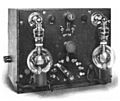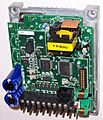Electronic system facts for kids
An electronic system is like a smart machine that uses electricity to do cool things! It takes in information or raw materials, processes them, and then gives you a useful output. Think of it as a brain that helps turn raw stuff into something amazing you can use every day.
Contents
What is an Electronic System?
An electronic system is a group of electronic parts that work together. These parts use electric signals to handle information. They can take in data, change it, and then send it out in a new form. This happens all around us, from your smartphone to a big factory machine.
How Electronic Systems Work
Electronic systems follow a simple path: input, processing, and output. They take signals from the real world, like temperature or sound. Then, they use special circuits to understand and change these signals. Finally, they turn the signals into something we can see, hear, or use.
Inputs: Sensing the World
Electronic systems need to know what's happening around them. This is where inputs come in.
- Sensors are like the eyes and ears of an electronic system. They can detect things like light, heat, pressure, or movement.
- These sensors then turn what they detect into tiny electric signals. Imagine a thermometer that doesn't just show the temperature, but also sends an electric message about it!
Signal Processing: The Brain of the System
Once the input signals are received, they go to the signal processing circuits.
- These circuits are made of many small electronic parts connected together.
- They work like a tiny brain, taking the electric signals and changing them. They can make the signals stronger, filter out noise, or even combine different signals.
- This is where the real "thinking" happens, turning raw data into useful information.
Outputs: Making Things Happen
After processing, the system needs to show or do something with the information. This is the output stage.
- Actuators are devices that turn electric signals back into actions. For example, a motor that spins, a light that turns on, or a speaker that makes sound.
- Other output devices might show information on a screen or print it out. This is how the electronic system communicates its work back to us.
Examples of Electronic Systems
Electronic systems are everywhere!
- Your smartphone is a complex electronic system. It takes your touch (input), processes it, and shows you apps (output).
- A robot uses sensors to see its surroundings (input), processes that information to decide what to do, and then moves its arms or legs (output).
- Even a simple light switch is part of an electronic system. It takes your finger press (input), completes a circuit (processing), and turns on a light (output).
Electronic systems make our lives easier and more connected. They are a key part of modern technology!
Images for kids
-
Modern surface-mount electronic components on a printed circuit board, with a large integrated circuit at the top.
-
One of the earliest Audion radio receivers, constructed by De Forest in 1914.
-
Electronics technician performing a voltage check on a power circuit card in the air navigation equipment room aboard the aircraft carrier USS Abraham Lincoln (CVN-72).
See also
 In Spanish: Electrónica para niños
In Spanish: Electrónica para niños





